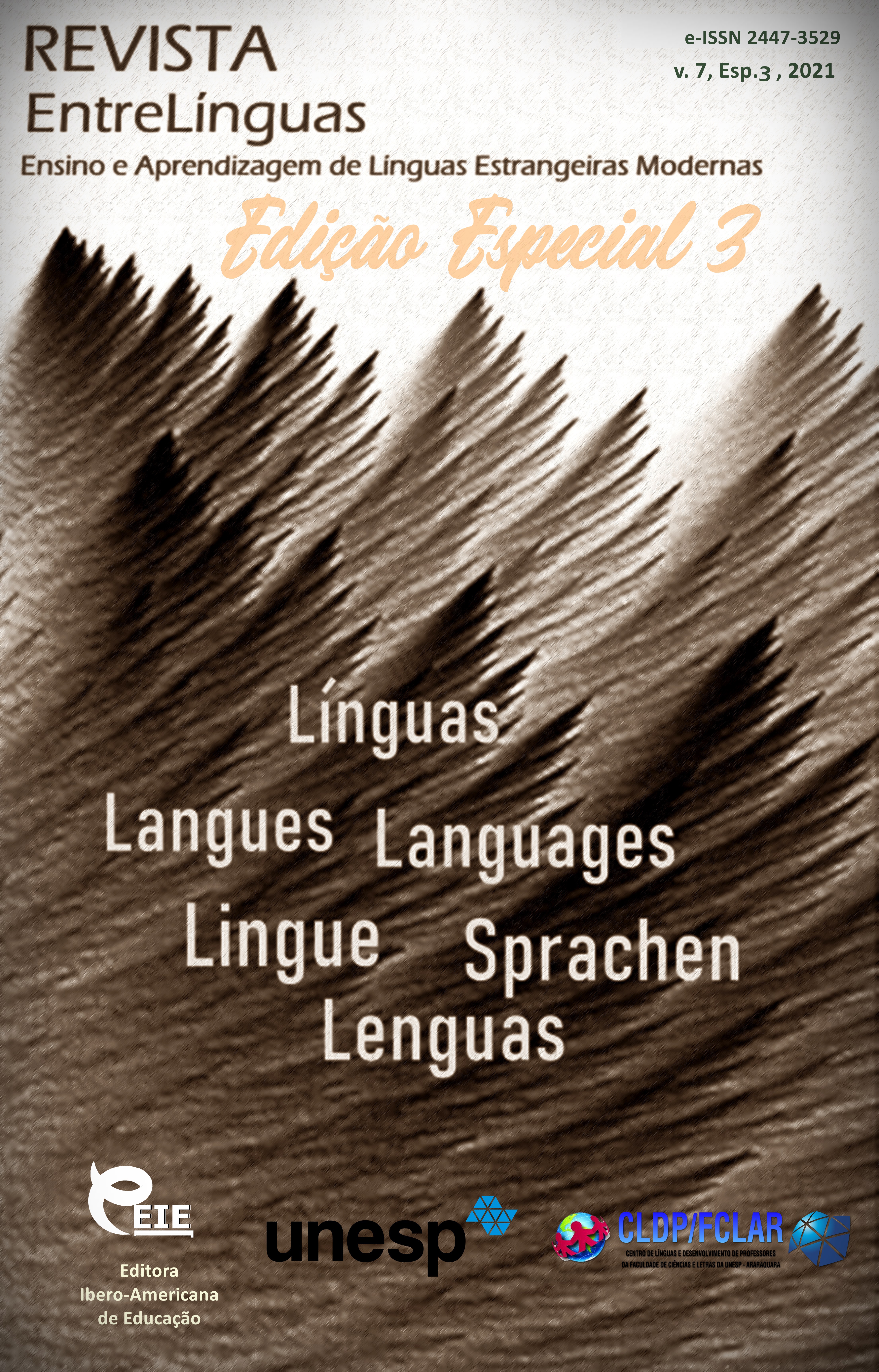Axiological aspect of modern german ethnosymbols in teaching german language
DOI:
https://doi.org/10.29051/el.v7iesp.3.15734Keywords:
Ethnosymbol, Axiological classification, Associative experiment, Linguocultural experimentAbstract
Based on the axiological approach, it has been established that the moral-ethical orientations of the German society have been internalized in the minds of the ethnos and verbalized by the ethnosymbols. An ethnosymbol is a motivated, conventional linguistic sign with multiple meaning that embodies important cultural meaningful concepts. The reasons for the formation of ethnosymbols are the specificity and duration of interethnic contacts, social, political and economic conditions for the development of ethnic groups. The semantic structure of the ethnosymbol is formed on the basis of national associative relationships commonly used in a particular sociolinguistic system of agreements. The aim of the article is to establish the value dominants of German culture on the basis of the analysis of ethnic symbols as important components of the linguistic picture of the world. Symbolic meaning as an associative rethinking of the direct and figurative meanings of the word involves taking into account the social function and ethnocultural specifics of the denoted object. National verbal associations are a prerequisite for the formation of symbolic semantics of the word, but the involvement of only linguistic methods does not provide a thorough and comprehensive study. The connection between language and language consciousness can be explored through an associative experiment. The results of such an experiment make it possible not only to establish the features of verbal memory, mental lexicon, cultural stereotypes, but also to reflect the specifics of the worldview of the language community. Most German ethnic symbols objectify such concepts as order, punctuality, purity, diligence, thrift. The set of the value dominants creates a certain type of the culture that has been maintained in the language and is transferred from generation to generation.
Downloads
References
BEIER, B. Harenberg lexikon der sprichwörter & zitate: mit 50000 Einträgen das umfassendste Werk in deutscher Sprache. [Harenberg Lexicon of Proverbs and Quotes: with 50000 entries the most comprehensive work in German]. Dortmund. Harenberg, 2004.
CREUZER, F. Symbolik und mythologie der alten völker, besonders der griechen. [Symbolism and mythology of the ancient peoples, especially the Greeks]. Hildesheim: Olms, 1973.
DORNSEIFF, F. Der deutsche wortschatz nach sachgruppen [The German vocabulary according to subject groups]. Berlin: Gruyter, 1965.
DUDEN. Das große wörterbuch der deutschen sprache: in zehn bänden. Duden. Wien-Zürich: Dudenverlag, 1999.
FLEISCHER, M. Weltbildgesteuerte wirklichkeitskonstruktion (beiträge zum phänomen weltbild) [Weltbild Controlled Reality Construction (Contributions to the Phenomenon Weltbild)]. München: Otto Sagner Verlag, 1996.
HÜLST, D. Symbol und soziologische symboltheorie. [Symbol and sociological symbol theory.] Opladen: Leske Budrich, 1999.
KLUGE, F. Etymologisches wörterbuch der deutschen sprache [Etymological dictionary of the German language] bearb. von Elmar Seebold. Berlin; New York: de Gruyter, 2002.
KROLL, W. Geschichte der klassischen philologie [History of Classical Philology]. Berlin: de Gruyter, 1919.
LIPPMANN, W. Public opinion. New York, NY: The Free Press, 1922.
MÜRI, W. Symbolon: wort- und sachgeschichtliche Studie [Symbolon: Word and historical study]. Bern, 1931.
MUSTAYOKI A. O. O lingvisticheskih eksperimentah [About longuistik experiments]. Moscow: IRYa RAN, 1995.
PAUL, H. Deutsches wörterbuch: bedeutungsgeschichte und aufbau unseres wortschatzes [German dictionary: history of meaning and structure of our vocabulary]. Tübingen: Niemeyer, 2002.
POTEBNYA, A. A. O nekotorykh simvolakh v slavyanskoi narodnoi poezii [About some symbols in the Slavic folk poetry]. Potebni, 1914.
PRYKHODKO, M. Kontsepty i kontseptosystemy [Concepts and concept systems]. Zaporizhzhya: Premyer, 2013.
SCHLESINGER, M. Geschichte des symbols [History of the symbol]. Hildesheim: Olms Verlag, 1967.
VESELOVSKY, A. N. Mif i simvol [Myth and symbol]. Russkii fol’klor: Voprosy teorii fol'klora [Russian folklore: Questions of folklore theory]. 1979. n. 19, p. 186-199.
WAHRIG, G. Deutsches wörterbuch mit einem lexikon der deutschen sprachlehre [German dictionary with a lexicon of German language teaching]. München: Bertelsmann, 1986.
WALDERMANN, A. Werbeslogans: geiz war geil geizistgeil der spiegel. 2007. Available at: http://www.spiegel.de/wirtschaft/werbeslogans-geiz-war-geil-a-485489.html. Access: 10 Dec. 2020.
WEHRLE, H.; EGGERS, E. Deutscher wortschatz: ein wegweiser zum treffenden ausdruck [German vocabulary: a guide to apt expression]. Stuttgart: Klett, 1967.
WINTER, A. Dem deutschen volke [For German people] München: DSZ-Verlag, 2009.
Published
How to Cite
Issue
Section
License

This work is licensed under a Creative Commons Attribution-NonCommercial-ShareAlike 4.0 International License.
Os manuscritos aceitos e publicados são de propriedade da Revista EntreLínguas. Os artigos publicados e as referências citadas na Revista EntreLínguas são de inteira responsabilidade de seus autores.
Transferência de direitos autorais – autorização para publicação
Caso o artigo submetido seja aprovado para publicação, já fica acordado que o(s) autor(es) autoriza(m) a UNESP a reproduzi-lo e publicá-lo na EntreLínguas, entendendo-se os termos “reprodução” e “publicação” conforme definição respectivamente dos incisos VI e I do artigo 5° da Lei 9610/98. O artigo poderá ser acessado pela rede mundial de computadores (Internet), sendo permitidas, a título gratuito, a consulta e a reprodução de exemplar do artigo para uso próprio de quem a consulta, desde que haja a citação ao texto consultado. Essa autorização de publicação 328 EntreLínguas, Araraquara, v. 1, n .2, p. 323-328, jul./dez. 2015 não tem limitação de tempo, ficando a UNESP responsável pela manutenção da identificação do(s) autor(es) do artigo. Os artigos publicados e as referências citadas na Revista EntreLínguas são de inteira responsabilidade de seus autores.











